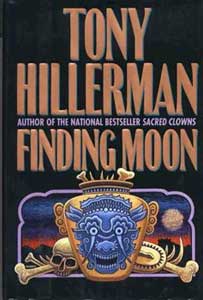No Ordinary Book
 I just finished my second reading of Finding Moon by Tony Hillerman, and I found it just as rewarding as the first. The second time through, you get a chance to examine a writer’s technique and see how the book is put together. This is a great book.
I just finished my second reading of Finding Moon by Tony Hillerman, and I found it just as rewarding as the first. The second time through, you get a chance to examine a writer’s technique and see how the book is put together. This is a great book.
I was delighted to learn that my favorite Tony Hillerman book was actually Tony Hillerman’s favorite Tony Hillerman book, too. His daughter Anne mentioned this in a comment on a previous post.
I’m looking forward to reading her book Tony Hillerman’s Landscape with photos of the geological features of the Southwest that play such a prominent role her father’s books. Then I can go back and read my Tony Hillerman books yet again and I’ll know what Shiprock looks like. They say it looks like a ship.
Finding Moon is about Moon Mathias, a middle-aged editor from Colorado, who sets off to find his deceased brother’s child in Cambodia just as South Vietnam is falling to the Viet Cong and the North Vietnamese and Cambodia is falling to the maniacal Khmer Rouge.
Millions of people are trying to get out of Vietnam and Cambodia and Moon is trying to get in. He is joined by an elderly Chinese man, Lum Lee, who wishes to get to the same village to retrieve an urn with the bones of his ancestor, and a Dutch woman from Indonesia, Osa van Winjgaarden, whose brother is a missionary among the Montagnards in a village nearby.
Lum Lee is very influential, and gets them to the Mekong Delta, where Moon’s brother Ricky had his helicopter repair company. They find the hangar, and there is a helicopter there and they have a pilot with them. So far so good.
But then retreating soldiers from the South Vietnamese Army of the Republic of Vietnam (ARVN) drive up in an armored personnel carrier with a 50-milimeter machine gun and take the helicopter and the pilot and fly away. Not good… but!
The armored personnel carrier turns out to be just like the ones Moon trained on in the Army Reserve in Oklahoma. He finds detailed maps in the hangar, and gas for the spare tanks, and revs her up and off they go. It’s a heck of a story. He refuels the vehicle from some abandoned tanks on the Cambodian border. Fortunately the Khmer Rouge are all busy attacking Phnomh Penh.
When they get to the village where Ricky’s child is being cared for by her grandmother (her mother has also been killed) there’s no one around. And they don’t find Lum Lee’s urn either, but he stays behind to look for it.
Then they set off for the Montagnard village and learn that Osa’s brother has been executed by the Khmer Rouge after refusing to identify the Montagnards who had converted to Christianity.
When they go back — this is a touch that I like — the villagers who had been in hiding see Lum Lee looking for the urn, and from the reverence he shows to the tombs, they know he’s a Buddhist, so they know he’s not with the Khmer Rouge. So they come out of hiding and tell Moon where he can find Ricky’s daughter. Lum Lee also finds his ancestral urn.
Getting out turns out to be a breeze. Saigon has just fallen and the Viet Cong are partying like it’s 1999. The pilgrims just hoist a Viet Cong flag and motor back to the delta, where they have a boat stashed. They take a little bit of small arms fire at the Cambodian border, but the two tanks are out of gas, so no worries. After that it’s a piece of cake.
Both times that I finished this book, I felt a wonderful uplifting feeling. The Vietnam War was a terrible tragedy and a blunder by our country, and nothing will change that. But this vision of peaceful pilgrims in a world gone mad reminded me of the transcendent power of human kindness that is in us all.
It made me think of what Faulkner said about the purpose of literature: to uplift men’s hearts. If a book can do that, it’s no ordinary book.
